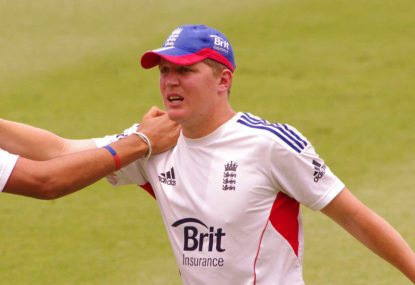Steve Smith’s suitability to batting at three is being questioned in England yet it is the home side who have the biggest problem at first drop for the Ashes.
The 25-year-old Gary Ballance has a fantastic Test record, with 1096 runs at 52. But he has been cowed by sides with quality pace attacks, averaging just 10 in six Test innings against New Zealand and Australia.
Perhaps England have been trying to distract from Ballance’s woes by questioning Australia’s decision to promote Smith to number three.
First retired spinner Graeme Swann and then chirpy bowler Stuart Broad suggested Smith’s technique may be exposed by the swinging Dukes ball.
The Australians will have nary a concern given Smith has played three matches involving a Dukes ball since moving to first drop and scored 394 runs while being dismissed just twice.
Several members of the British press have suggested Broad and James Anderson will be excited to get an early crack at Smith.
Well, Australia’s pacemen will be positively euphoric about what they saw from Ballance against New Zealand and on his debut in the fifth Ashes in Sydney Test 18 months back.
For all the talk of Smith’s supposedly dodgy technique, Ballance’s deficiencies are more significant.
When he last played Australia in white clothing it was noticeable how rarely he made a full stride towards the ball, even when it was well pitched up.
Regularly he was caught on the crease, which was the same bad habit which caused him major issues against New Zealand’s quicks last month.
In this manner, he resembled the Joe Root we saw in the past Ashes. While Root has since honed his approach and improved dramatically, in those series he was an extremely one-dimensional batsman and struggled to hit Australia’s fast bowlers off the square.
The cause was his desire to constantly play from the crease or off the back foot, looking to slice the ball away on the offside.
Australia’s talented pacemen, particularly Ryan Harris, were full and straight to Root, who floundered in the face of these tactics.
Root is now far better equipped to tackle such a strategy but the Australians will fancy it can work against Ballance.
The Zimbabwean-born batsman’s first movement is to take a half-step back inside his crease.
When the ball is full of length he often then makes a hesitant half step forward, which leaves his front foot either on or barely outside of the crease. This is no man’s land.
Against the ordinary pace attacks of India, Sri Lanka and the West Indies, this weakness was not exploited.
However, New Zealand made sure to punish Ballance for his faulty footwork. They were happy to risk bowling half volleys to try to ensure he got no back-of-a-length deliveries to cut away or nudge off his hip.
When he edged Trent Boult to third slip in the first innings of the first Test, it was from a delivery so full that most batsman would have met it on the half volley and creamed it down the ground for four.
Instead, Ballance was bolted to the crease and hurriedly stabbed his bat down at the ball as if it was a perfect yorker, rather than an eminently driveable delivery.
In the second innings, Ballance was again out cheaply, clean bowled by Tim Southee.
Conventional cricket thinking is that if a pace delivery is full enough to hit your stumps you should be playing it off the front foot. Again, Ballance was camped out deep in the crease and so was unable to smother the movement Southee gained off the deck.
The second Test saw more of the same. First up, Ballance was castled while trying to combat a pitched up swinger from Boult without the required feet movement.
In the second dig, New Zealand’s bowlers blanketed him and after crawling to 6 from 26 balls he was bowled once more, the same technical problem again contributing to his downfall.
In Harris, Josh Hazlewood and Mitchell Starc, Australia have three bowlers who like to target a full length and bend the ball. Mitchell Johnson is also capable of such offerings although slightly less inclined.
Harris and Hazlewood are both wonderful bowlers to left-handers with their relentless accuracy and ability to swing the ball in at them before making the occasional delivery jag away off the seam.
But it was the left-arm out swing of Boult which most troubled Ballance and in Starc Australia have the closest thing to the New Zealand star.
Then there’s the fact that, when bowling to Ballance, offie Nathan Lyon will be able to capitalise on the footmarks created by Johnson and Starc.
Australia’s bowling unit is perfectly composed to devour a batsman like Ballance. It is the Zimbabwean-turned-Englishman who faces the nightmare task at first drop, not Smith.





























































































